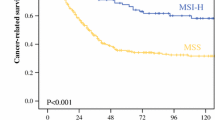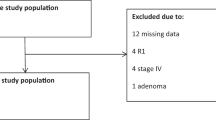Abstract
PURPOSE: In case-control studies, it was reported that microsatellite instability might be helpful in predicting the development of metachronous multiple colorectal cancers. The purpose of this cohort-like study was to determine whether microsatellite instability is a novel independent marker in predicting metachronous colorectal carcinomas after colorectal cancer surgery. METHODS: Three hundred twenty-eight colorectal carcinoma patients were surveyed by periodic colonoscopy for at least three years after surgery. Among these, DNA from paraffin-embedded sections was available for 272 cases. DNA of these cases was studied for six microsatellite markers (five dinucleotide repeats, one mononucleotide repeat). Microsatellite instability phenotype was defined as alterations in one or more loci. RESULTS: Median follow-up period was 74 months, and the median number of colonoscopies was 4.6. The percentage of microsatellite instability-positive cases was 26.4 percent (72/272). Seventeen metachronous colorectal carcinomas were detected during the follow-up period. Incidences of metachronous colorectal carcinomas in microsatellite instability-positive and microsatellite instability-negative cases were 15.3 and 3 percent, respectively (P < 0.001). The cumulative five-year incidence of metachronous colorectal carcinomas was significantly higher in microsatellite instability-positive cases than in microsatellite instability-negative cases (12.5 vs. 2.5 percent, P < 0.0001). Logistic regression analysis of the relationship between incidence of metachronous colorectal carcinomas and possible risk factors (namely, coexistence of adenoma at the time of surgery, family history of colorectal carcinoma , history of extracolonic malignancy, and microsatellite instability status) showed that microsatellite instability and coexistence of adenoma were significant independent risk factors for the occurrence of metachronous colorectal carcinomas, with values of P = 0.001 and 0.02, respectively. CONCLUSION: These data indicate that microsatellite instability can be regarded as a novel independent and important marker for predicting the development of metachronous colorectal carcinoma after surgery.
Similar content being viewed by others
References
SH Landis T Murray S Bolden PA Wingo (1998) ArticleTitleCancer statistics, 1998. CA Cancer J Clin 48 6–29
RL Cali RM Pitsch AG Thorson et al. (1993) ArticleTitleCumulative incidence of metachronous colorectal cancer. Dis Colon Rectum 36 388–393
K Togashi F Konishi A Ozawa et al. (2000) ArticleTitlePredictive factors for detecting colorectal carcinomas in surveillance colonoscopy after colorectal cancer surgery. Dis Colon Rectum 43 47–53
F Chen M Stuart (1994) ArticleTitleColonoscopic follow-up of colorectal carcinoma. Dis Colon Rectum 37 568–572
O Kronborg E Hage E Deichgraeber (1983) ArticleTitleThe remaining colon after radical surgery for colorectal cancer: Dis Colon Rectum 26 172–176
SB Sengupta CY Yin PB Boulos MD Silva VR Sams JD Delhanty (1997) ArticleTitleGenetic instability in patients with metachronous colorectal cancers. Br J Surg 84 996–1000
S Masubuchi F Konishi K Togashi et al. (1999) ArticleTitleThe significance of microsatellite instability in predicting the development of metachronous multiple colorectal carcinomas in patients with nonfamilial colorectal carcinoma. Cancer 85 1917–1924
K Shitoh F Konishi S Masubuchi S Senba T Tsukamoto K Kanazawa (1998) ArticleTitleImportant microsatellite markers in the investigation of replication errors (RER) in colorectal carcinomas. Jpn J Clin Oncol 28 538–541
S Senba F Konishi T Okamoto et al. (1998) ArticleTitleClinicopathologic and genetic features of nonfamilial colorectal carcinomas with DNA replication errors. Cancer 82 279–285
CG Moertel JA Bargen MB Dockerty (1958) ArticleTitleMultiple carcinomas of the large intestine. Gastroenterology 34 85–98
D Hojman RA Garriz I Markman (1966) ArticleTitleMultiple malignant tumors of the colon and rectum. Dis Colon Rectum 9 121–126
S Warren O Gates (1932) ArticleTitleMultiple primary malignant tumors: Am J Cancer 16 1358–1414
HJ Bussey MH Wallace BC Morson (1967) ArticleTitleMetachronous carcinoma of the large intestine and intestinal polyps. Proc R Soc Med 60 208–210
WE Enker S Dragacevic (1978) ArticleTitleMultiple carcinomas of the large bowel: Ann Surg 187 8–11
H Muta M Noguchi M Perucho et al. (1996) ArticleTitleClinical implications of the microsatellite instability in colorectal cancers. Cancer 77 265–270
LA Aaltonen P Peltomaki FS Leach et al. (1993) ArticleTitleClue to the pathogenesis of familial colorectal cancer. Science 260 812–816
SN Thibodeau G Bren D Schaid (1993) ArticleTitleMicrosatellite instability in cancer of the proximal colon. Science 260 816–819
Y Ionov MA Peinado S Malkhosyan D Shibata M Perucho (1993) ArticleTitleUbiquitous somatic mutations in simple repeated sequences reveal a new mechanism for colonic carcinogenesis. Nature 363 558–561
M Konishi R Kikuchi-Yanoshita K Tanaka et al. (1996) ArticleTitleMolecular nature of colon tumors in hereditary nonpolyposis colon cancer, familial polyposis, and sporadic colon cancer. Gastroenterology 111 307–317
H Kim J Jen B Vogelstein SR Hamilton (1994) ArticleTitleClinical and pathological characteristics of sporadic colorectal carcinomas with DNA replication errors in microsatellite sequences. Am J Pathol 145 148–156
L Cawkwell D Li FA Lewis I Martin MF Dixon P Quirke (1995) ArticleTitleMicrosatellite instability in colorectal cancer: Gastroenterology 109 468–471
A Horii HJ Han M Shimada et al. (1994) ArticleTitleFrequent replication errors at microsatellite loci in tumors of patients with multiple primary cancers. Cancer Res 54 3373–3375
S Bulow LB Svendsen A Mellemgaard (1990) ArticleTitleMetachronous colorectal carcinoma. Br J Surg 77 502–505
HJ Jarvinen M Aarnio H Mustonen et al. (2000) ArticleTitleControlled 15-years trial on screening for colorectal cancer in families with hereditary nonpolyposis colorectal cancer. Gastroenterology 118 829–834
Author information
Authors and Affiliations
About this article
Cite this article
Shitoh, K., Konishi, F., Miyakura, Y. et al. Microsatellite Instability as a Marker in Predicting Metachronous Multiple Colorectal Carcinomas After Surgery. Dis Colon Rectum 45, 329–333 (2002). https://doi.org/10.1007/s10350-004-6177-1
Issue Date:
DOI: https://doi.org/10.1007/s10350-004-6177-1




